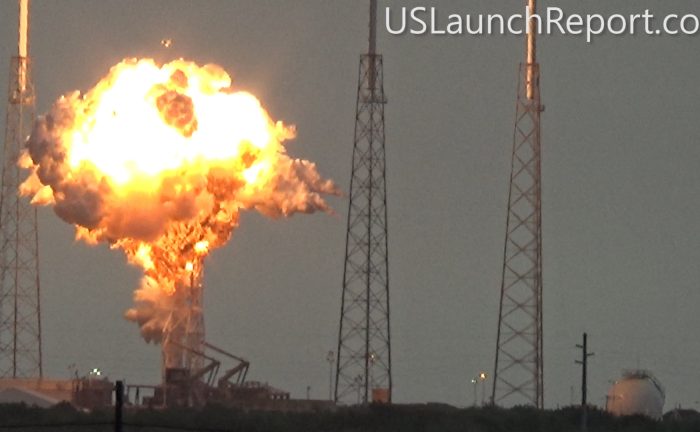Big Breach In 2nd Stage Helium System Likely Triggered Catastrophic Falcon 9 Explosion: SpaceX

Investigators have determined that a “large breach” in the second stage helium system likely triggered the catastrophic Falcon 9 launch pad explosion that suddenly destroyed the rocket and Israeli commercial payload during a fueling test three weeks ago, SpaceX announced today, Friday, Sept. 23.
However, the root cause of the Sept. 1 disaster has not been determined, according to SpaceX, based on the results thus far discerned by the official accident investigation team probing the incident that forced an immediate halt to all SpaceX launches.
The Accident Investigation Team (AIT) is composed of SpaceX, the FAA, NASA, the U.S. Air Force, and industry experts.
“At this stage of the investigation, preliminary review of the data and debris suggests that a large breach in the cryogenic helium system of the second stage liquid oxygen tank took place,” SpaceX reported on the firm’s website in today’s anomaly update dated Sept. 23- the first in three weeks.
The helium system is used to pressurize the liquid oxygen tank.
The explosion took place without warning at SpaceX’s Space Launch Complex-40 launch facility at approximately 9:07 a.m. EDT on Sept. 1 on Cape Canaveral Air Force Station, Fl, during a routine fueling test and engine firing test for the launch of the AMOS-6 comsat planned two days later.
Indeed the time between the first indication of an anomaly to loss of signal was vanishingly short – only about “93 milliseconds” of elapsed time, SpaceX reported.
93 milliseconds amounts to less than 1/10th of a second. That conclusion is based on examining 3,000 channels of data.
SpaceX reported that investigators “are currently scouring through approximately 3,000 channels of engineering data along with video, audio and imagery.”
Both the $60 million SpaceX rocket and the $200 million AMOS-6 Israeli commercial communications satellite payload were completely destroyed in a massive fireball that erupted suddenly during the planned pre-launch fueling and hot fire engine ignition test at pad 40.
The Sept. 1 calamity also counts as the second time a Falcon 9 has exploded in 15 months and the second time it originated in the second stage and will call into question the rocket’s reliability.
The first failure involved a catastrophic mid air explosion about two and a half minutes after liftoff, when a strut holding the helium tank inside the liquid oxygen tank failed in flight during the Dragon CRS-7 cargo resupply launch for NASA to the International Space Station on June 28, 2015 – and witnessed by this author.
However SpaceX says the although both incidents involved the second stage, they are unrelated, and as they seek to determine to the root cause.
“All plausible causes are being tracked in an extensive fault tree and carefully investigated. Through the fault tree and data review process, we have exonerated any connection with last year’s CRS-7 mishap.”
And they are thoroughly reviewing all rocket components.
“At SpaceX headquarters in Hawthorne, CA, our manufacturing and production is continuing in a methodical manner, with teams continuing to build engines, tanks, and other systems as they are exonerated from the investigation.”
But SpaceX will have to conduct an even more thorough analysis of every aspect of their designs and manufacturing processes and supply chain exactly because the cause of this disaster is different and apparently when undetected during the CRS-7 accident review.
Since the explosion showered debris over a wide area, searchers have been prowling surrounding areas and other nearby pads at the Cape and Kennedy Space Center for evidentiary remains that could provide clues or answers to the mystery of what’s at the root cause this time.
Searchers have recovered “the majority of debris from the incident has been recovered, photographed, labeled and catalogued, and is now in a hangar for inspection and use during the investigation.”
SpaceX CEO Elon Musk had previously reported via twitter that the rocket failure originated somewhere in the upper stage near the liquid oxygen (LOX) tank during fueling test operations at the launch pad, for what is known as a hot fire engine ignition test of all nine first stage Merlin 1D engines.
Engineers were in the final stages of loading the liquid oxygen (LOX) and RP-1 kerosene propellants that power the Falcon 9 first stage for the static fire test which is a full launch dress rehearsal. The anomaly took place about 8 minutes before the planned engine hot fire ignition.
And the incident took place less than two days before the scheduled Falcon 9 launch of AMOS-6 on Sept. 3 from pad 40.
The explosion also caused extensive damage to the launch pad as well as to the rockets transporter erector, or strongback, that holds the rocket in place until minutes before liftoff, and ground support equipment (GSE) around the pad – as seen in my recent photos of the pad taken a week after the explosion during the OSIRIS-REx launch campaign.
Fortunately, many pads areas survived intact or in good condition.
“While substantial areas of the pad systems were affected, the Falcon Support Building adjacent to the pad was unaffected, and per standard procedure was unoccupied at the time of the anomaly. The new liquid oxygen farm – e.g. the tanks and plumbing that hold our super-chilled liquid oxygen – was unaffected and remains in good working order. The RP-1 (kerosene) fuel farm was also largely unaffected. The pad’s control systems are also in relatively good condition.”
Stay tuned here for Ken’s continuing Earth and Planetary science and human spaceflight news.
The post Big Breach In 2nd Stage Helium System Likely Triggered Catastrophic Falcon 9 Explosion: SpaceX appeared first on Universe Today.